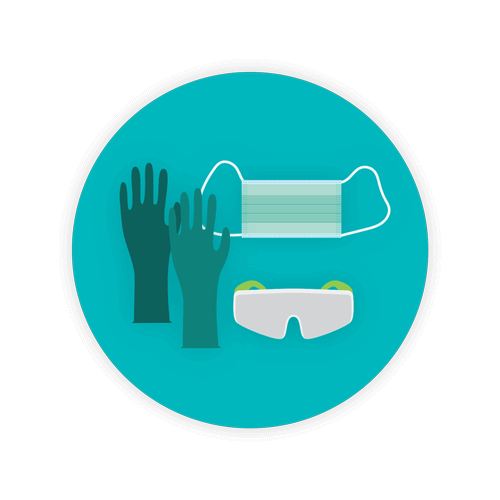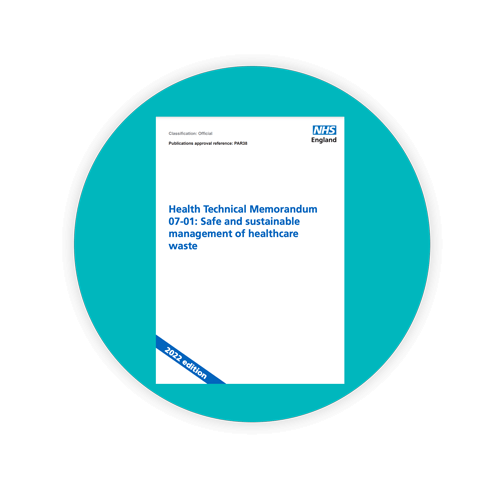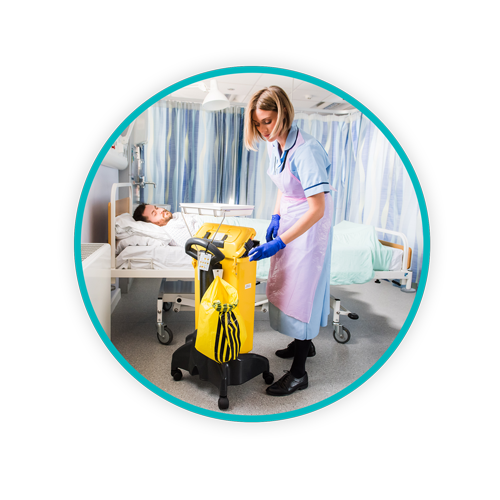How Offensive Waste Drives Sustainability in Healthcare

If you’re working in a healthcare setting, chances are you’ve heard of offensive waste. This waste stream is one of the biggest components of reducing the amount of waste being unnecessarily sent for carbon-intensive treatments; making a positive impact on the high carbon emissions associated with healthcare waste. Utilising the offensive waste stream has been proven to drive sustainability in healthcare and significantly reduce carbon footprint, but there is a problem…
TOPICS WE WILL COVER:
2 / The problem with offensive waste in healthcare
3 / Introducing and supporting the offensive waste stream
4 / How offensive waste drives sustainability in healthcare
5 / Is your offensive waste stream working for you?
What is Offensive Waste?
Offensive waste is defined as recognisable waste that is non-infectious and doesn’t contain any pharmaceutical or chemical substances. It’s the most common healthcare waste stream and may be unpleasant to those who come into contact with it.
Examples of offensive waste include PPE and wastes generated from the care of a non-infectious patient such as outer dressings, nappies and incontinence pads.
The Problem With Offensive Waste in Healthcare

To aid the Greener NHS efforts to reach net zero carbon emissions, targets to improve waste segregation and introduce the offensive waste stream are being and have been implemented. However, there is a problem with offensive waste in healthcare…
The underlying problem with offensive waste is that it’s often seen as an easy route to save on waste management costs. Although substantial cost savings can be made, mismanagement and bad segregation practices can result in costly non-conformances and the loss of disposal options.
It also has a knock-on effect of detrimental consequences such as:
- Waste being incorrectly consigned as high-temperature incineration (HTI) or alternative treatment (AT) and being unnecessarily overtreated, resulting in challenges with available incineration capacity and overspending.
- Offensive waste is often sent either to landfill or incineration in ageing clinical waste incinerators resulting in minimal to no waste-to-energy recovery.
-
Many domestic incinerators and some landfill sites no longer accept offensive waste due to the perceived risk, visual appearance and poor segregation so often seen.
The UK standards are clear that to be compliant, all waste streams including offensive waste must be properly segregated, stored, and handled from point of production through to final disposal. Healthcare providers producing waste should understand and follow the guidance published in the Department of Health’s Health Technical Memorandum 07-01: Safe and Sustainable Management of Healthcare Waste. Although offensive waste presents unique challenges, when used correctly it can bring about significant cost savings and real environmental benefits.
Introducing and Supporting the Offensive Waste Stream
To overcome the problems with offensive waste identified in the previous section, the offensive waste stream needs to be introduced and supported effectively.
Sharpsmart’s solution to introducing and supporting the offensive waste stream is to implement behavioural change systems to achieve the highest levels of segregation. This approach ensures that the levels of offensive waste are increased and the amount of clinical waste sent for high-temperature incineration and alternative treatment is reduced.
Here’s how we solve the problem of offensive waste in healthcare:
- Our on-site technicians ensure the correct segregation of offensive waste from point of production to the waste compound by implementing the Bag-to-Bed system*.
- The offensive and general wastes are processed through our waste system to produce an unrecognisable fuel stock, reducing waste volumes and vehicle movements.
- The refuse-derived fuel (RDF) is less than 50mm in size and completely unrecognisable as healthcare waste, meaning it can be used as fuel in modern, highly efficient energy-from-waste (EfW) facilities nationwide.
-
This moves offensive waste in the waste hierarchy from the “disposal” tier up to the “generate for energy sources” tier as it eliminates the need for landfill or clinical incineration, ultimately achieving a more robust, cost-effective and sustainable solution for offensive waste.
There are a number of case studies that showcase how Sharpsmart’s partners have successfully implemented the offensive waste stream at their respective sites. A recent case study comes from Liverpool Women’s Hospital where the introduction of the Bag-to-Bed system enabled them to divert 40% of waste from high-temperature incineration (HTI), delivering a cost saving of around 45%.
*The Bag-to-Bed is a behavioural change system with strategically placed bag holders, bag dispensers, and blended learning materials which introduce the offensive waste stream, as well as ingraining compliant segregation practices. The system typically results in a 40-70% diversion of clinical waste into the offensive and other waste streams, resulting in a significant reduction in waste management costs.
How Offensive Waste Drives Sustainability in Healthcare
By introducing the offensive waste stream and ensuring correct segregation the overtreatment of waste is easily avoidable; resulting in the diversion of the majority of generated healthcare waste from carbon-intensive treatments such as high-temperature incineration.
As part of its Clinical Waste Strategy, NHS England encourages a 20-20-60 split of healthcare waste sent for treatment which breaks down as:
- 20% of waste sent for high-temperature incineration;
- 20% of waste sent for alternative treatment (AT);
-
60% of waste classified as offensive waste, which can be converted into energy.
By improving segregation practices and adhering to the recommended waste split you’ll be using offensive waste to drive one of the most sustainable and cost-effective solutions to healthcare waste management there is. The 2021-22 financial year saw a 44% increase in the volume of offensive waste generated by the NHS when compared to the previous financial year; this is a promising increase that if we project forward can see having a significant impact on sustainability in healthcare waste management.
The continued reduction of waste unnecessarily sent for high-temperature incineration is a huge step in the right direction on the route to net zero.

Is Your Offensive Waste Stream Working for You?
At Sharpsmart, we’re working with our partners across the UK to achieve Net Zero Together and one of the many ways we’re doing that is through the introduction and support of the offensive waste stream.
Through innovative solutions, behavioural change systems and blended learning materials, we work with you within the four walls of your facility to drive positive change and get the most out of your healthcare waste management. Get in touch with one of our waste experts today and start using the offensive waste stream to its fullest.
